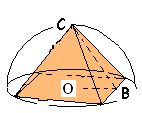| THERMO Spoken Here! ~ J. Pohl © | TOC NEXT ~ 9 |
Pharaoh's Engineers

The Great Pyramid of Egypt was constructed to precise proportions. A hypothesis is that the pyramid was constructed to fit inside an imaginary hemisphere with each its corners and its peak touching the hemisphere. The sketch below right shows this hypothesized geometry. The angle 0BC each face makes with the horizontal is indicated.

Determine Angle 0BC, as predicted by the hypothesis.
♦ Vectors work well in three dimensions but physical situations do not come with coordinates
and unit vectors. The vector basis must be constructed: below right.
We define the center of the pyramid at its base as our origin with coordinates 0,0,0. We apply X, Y, and Z axes in parallel to the pyramid sides and vertical. We use the vector triple, I, J and K as our basis.
We seek the angle OBC. The approach is always the same. We write a vector to some point the path of which includes the sought angle (or length). Next write a second vector to the same point, equate the two vectors. The peak and corners of the pyramid contact the hemisphere. We write the position of the peak of the pyramid in two independent ways.
 An origin, coordinates, and
An origin, coordinates, and
vector basis are applied.
A vector represented as OC extends from the origin vertically to the peak of the pyramid. The notation
OC means a vector starting at the point "O" and extending to (and directed toward) the point "C."
We see another path to the peak as the sum of three vectors. Our working equation is the equality of these two representations of position of the same point, the peak of the pyramid.
| $$\hspace{-3cm} \overline{OA}+\overline{AB}+\overline{BC}=\overline{OC}$$ | (1) |
the path, 0-to-C... straight up.
The above is an implicit vector statement. To proceed we make as many of the components explicit (in terms of dimensions and the unit vector basis) as we are able.
OA = r (cos 45 I + sin 45 J)
$$\overline{OA}=r(cos\; 45^\circ \overline{I}+sin\; 45^\circ \overline{J})$$The letter, " r " represents the radius of the hemisphere.
Since we do not know the length of vector AB we write it as:
AB = |AB|J
$$\overline{AB}=| \overline{AB}|\overline{J}$$The notation, |AB|, means length of the vector AB and its direction is that of the unit vector I.
The vector BC has an unknown length. Its direction is written using the unknown angle, α. The vectors are written then equated.
r (cos 45 I + sin 45 J) + |AB|J + |BC|[cosα(- I) + sinαK] = r K
$$r(cos\; 45^\circ \overline{I}+sin\; 45^\circ \overline{J})+| \overline{AB}|\overline{J}+| \overline{BC}|[cos \; a(- \overline{I})+sin \; a \overline{K}]=r \overline{K}$$The above procedure is typical. At this point, we check it to assure it is correct. Next we regroup the equation in accord with the vector triad.
[r cos45 - |BC|cosα ] I + [|AB| - r sin45 ] J + [ |BC|sinα - r ] K = 0
$$[r cos \; 45-|\overline{BC}|cos \; a]\overline{I}+[|\overline{AB}|-r sin \; 45]\overline{J}+[|\overline{BC}|sin \; a-r]\overline{K}=0$$By its right side we see this equation expresses a vector that is zero. The only way that can happen is if each component magnitude of the vector equals zero. Thus we have:
From the I component we obtain:
r cos45 - |BC| cosα = 0
The J component provides:
|AB| - r sin45 = 0
and for the K component, we have:
|BC| sinα - r = 0
Combining the I and K components we determine:
tan α = √2 whereupon α = 54°
The actual, measured value of this angle is 51°.Thus the hypothesis is quite close!